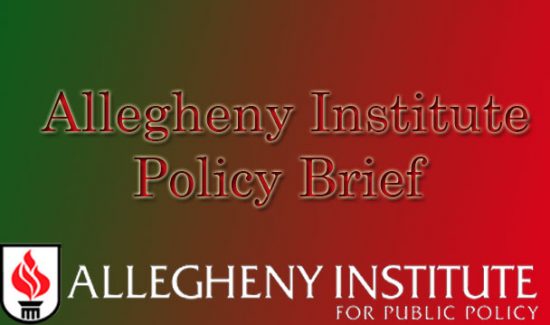Questioning Those ‘Livability’ Rankings

“Livability” rankings have been all the rage for a number of years. Various entities devise the ratings; the media dutifully report them with little or no context. Public officials and booster organizations then tout the most laudatory rankings and reports as proof-positive that their respective cities and/or regions are “getting it right” or “on the move” or some other feel-good bromide.
But as two recent cases illustrate, all ranking methodologies are not created equal and some of the criteria employed are suspect, bordering on “bogus,” according to an analysis (Policy Brief Vol. 18, No. 38) by the Allegheny Institute for Public Policy.
It was in August that The Economist Intelligence Unit (EIU) ranked Pittsburgh as the 32nd most-livable city in the world and second-best in the United States (behind Honolulu). But this past spring, U.S. News & World Report ranked Greater Pittsburgh 57th in its “Best Places to Live” rankings (with Honolulu ranked 35th).
“So, can anything useful be gleaned from these rankings?” ask Frank Gamrat, executive director of the Pittsburgh think tank, and Jake Haulk, its president emeritus and senior advisor. “Or are they essentially a meaningless exercise?”
The Economist’s methodology utilized qualitative (non-numeric) and quantitative (numeric) measures to rank cities. The former was based on the judgment of an in-house expert on a respective country and a field correspondent in each city.
Of the 30 categories gauged, only four (or 13 percent) were quantitative, or data-driven, while 26, or 87 percent, were qualitative, based on the judgment of individuals.
“Thus, the EIU ranking methodology is extraordinarily subjective rather than based on objective, verifiable facts – which is appropriate since the whole notion of ‘livability’ is very subjective,” Gamrat and Haulk say.
That said, many of The Economist’s rankings defy credulity.
Take, for instance, Pittsburgh’s best score – 100, or “ideal” — in the EIU’s education category in which the availability of private education and the quality of that and public education were considered. The EIU measure did not delineate what aspects of education were evaluated – k-12, higher education or both.
But if the focus was on k-12, the Allegheny Institute repeatedly has documented Pittsburgh Public Schools’ morass.
“Consider that just over a year and a half ago the district was excoriated by the Council of the Great City Schools for not improving student achievement in 10 years,” the scholars stress. “Anyone following Pittsburgh schools should have known about that extremely critical study.
“In short, the EIU ranking on education is bogus,” say Gamrat and Haulk.
Additionally, The Economist ranks Pittsburgh’s infrastructure quite high (at 96.4). But it makes no mention of the abject failures, operationally and financially, of the Pittsburgh Water and Sewer Authority.
Neither does it appear that the EIU study took into account the outrageously high cost of bus service by the Port Authority of Allegheny County – second-highest in the nation behind only New York City. Perhaps it was blinded by the faux glitter of the severely truncated and over-budget North Shore Connector light-rail line.
Nor did the judgment of the experts include the use of millions of dollars in public subsidies to pervert the market and attempt to command demand by propping up new airlines and/or flights at Pittsburgh International Airport.
Then there’s the EIU’s take on Pittsburgh’s heavily publicly subsidized cultural amenities, which, at 87.7, was lowest of all its scoring.
“Given the amount of money the taxpayers have ponied up for world-class sporting facilities, not to mention the Regional Asset District subsidies handed out to cultural amenities, city officials must undoubtedly believe they were short-changed on this category,” Gamrat and Haulk add.
Contrast The Economist study, heavy on the qualitative, with the more quantitative-based U.S. News study and the fact-based conclusions are sobering. Again, the U.S. News analysis covers the seven-county metropolitan statistical area (MSA) and not the city proper itself.
It scored Greater Pittsburgh poor on net migration; poor for its stagnant employment climate that, as the Allegheny Institute repeatedly has noted, lacks more meaningful goods-producing jobs; a generally poor quality of life (determined by the crime rate; quality and availability of health care; “well-being” and a commuter index).
The respective livability rankings offer a contrast in styles and shed two different lights on the city and region. The EIU ranking looks mostly at the city through subjective and possibly a very biased observer lens.
“It doesn’t take into account any of the hard data on the cost of government or the cost of providing services such as education or transportation,” areas for which the think tank has found “Pittsburgh to be woefully lacking when compared to other cities,” Gamrat and Haulk reiterate.
On the other hand, the U.S. News rankings used more hard data from the U.S. Census and Bureau of Labor Statistics to draw a starkly different assessment.
“The economy of the metro” – and as the Allegheny Institute has demonstrated for the City of Pittsburgh proper – “as measured by jobs data, has been stagnant for quite some time. … Weak job gains and little or no net migration are undoubtedly related,” the researchers say.
“The city and the MSA’s poor business climate are key elements in the comparatively weak economic performance,” Gamrat and Haulk remind. “And unfortunately (they) are likely to continue to be a drag on the economy.”
One would not know that, however, from the Economist Intelligence Unit’s methodology and the media’s context-lacking reportage.
Colin McNickle is communications and marketing director at the Allegheny Institute for Public Policy ([email protected]).




